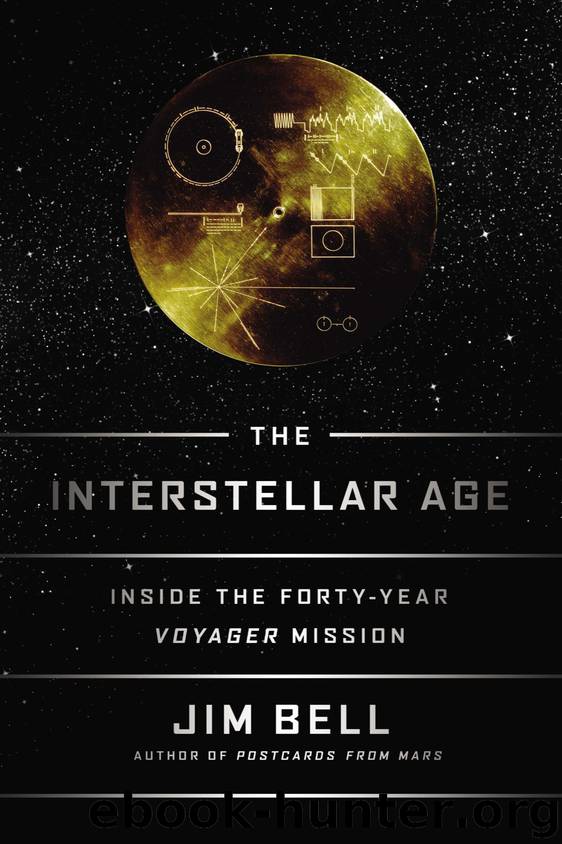The Interstellar Age by Jim Bell

Author:Jim Bell
Language: eng
Format: epub
Publisher: Penguin Publishing Group
Published: 2015-02-09T16:00:00+00:00
ROLLING WITH THE PUNCHES
When William and Caroline Herschel discovered Oberon and Titania, they and others couldn’t help but notice that those moons (and others found later) are spinning around Uranus in a vertical plane, like the wheels on a car rather than like a record on a turntable. The spin axis of Uranus is tilted on its side, at an angle close to 90 degrees relative to the rest of the planets. Uranus rolls around the sun, rather than spins. What’s up with that? One of the main goals of the Voyager 2 flyby of Uranus was to try to find some clues to answer that question.
To try to come up with some ideas ahead of time, astronomers tried to understand why all the other planets spin like tops with their poles pointed roughly (within 20 to 30 degrees or so) perpendicular to the equator of the sun. The prevailing idea is that the sun and all the planets formed some 4.65 billion years ago from a condensing, spinning cloud of gas and dust. The cloud must have been spinning counterclockwise as viewed from above the north pole of the sun, because that’s the direction that the sun spins on its axis and that all the planets orbit around the sun. The notion that the planets formed from a disk of gas and dust helps to explain why their poles are pointed north-south: their equators are all forming within the plane of that relatively flat disk. But Uranus is an oddball: its equator is tipped over by 90 degrees. For part of its eighty-four-Earth-year trip around the sun, the north pole of Uranus is pointed right at the sun, and the entire southern hemisphere is dark; forty-two Earth years later the situation is reversed in southern summer, with the northern hemisphere in the complete darkness of polar night. In between, near the spring and fall equinoxes, sunlight falls on both hemispheres. A planet’s tilt determines the intensity of its seasons: Earth’s 23.5-degree tilt produces extreme seasons with constant sunlight or constant darkness for people or animals that live above the Arctic (or Antarctic) circles; Jupiter’s tilt is near 0 degrees, and so despite being superlative in many things, it has no seasons. Uranus has the most extreme tilt and thus the most extreme seasons, with its own Arctic circle falling very close to its equator.
How did Uranus get this way? No one knows for sure, but one popular hypothesis is that Uranus formed “normally” like the rest of the planets, but early in the history of the solar system it was knocked on its end, tipped over, by a giant grazing impact with another large terrestrial planet or a small gas giant. That impact would have essentially melted both bodies, but if a newly forming condensing cloud of post-impact gas and dust had started to spin vertically because of the force of the impact, that orientation could end up being the new tilt for a newly formed (potentially merged) planet.
It sounds outrageous and ad hoc .
Download
This site does not store any files on its server. We only index and link to content provided by other sites. Please contact the content providers to delete copyright contents if any and email us, we'll remove relevant links or contents immediately.
| Aerodynamics | Aircraft Design & Construction |
| Astronautics & Space Flight | Avionics |
| Gas Dynamics | Propulsion Technology |
Whiskies Galore by Ian Buxton(41867)
Introduction to Aircraft Design (Cambridge Aerospace Series) by John P. Fielding(33064)
Small Unmanned Fixed-wing Aircraft Design by Andrew J. Keane Andras Sobester James P. Scanlan & András Sóbester & James P. Scanlan(32743)
Craft Beer for the Homebrewer by Michael Agnew(18140)
Turbulence by E. J. Noyes(7935)
The Complete Stick Figure Physics Tutorials by Allen Sarah(7307)
Kaplan MCAT General Chemistry Review by Kaplan(6866)
The Thirst by Nesbo Jo(6826)
Bad Blood by John Carreyrou(6543)
Modelling of Convective Heat and Mass Transfer in Rotating Flows by Igor V. Shevchuk(6391)
Learning SQL by Alan Beaulieu(6208)
Weapons of Math Destruction by Cathy O'Neil(6139)
Man-made Catastrophes and Risk Information Concealment by Dmitry Chernov & Didier Sornette(5921)
Digital Minimalism by Cal Newport;(5661)
Life 3.0: Being Human in the Age of Artificial Intelligence by Tegmark Max(5474)
iGen by Jean M. Twenge(5366)
Secrets of Antigravity Propulsion: Tesla, UFOs, and Classified Aerospace Technology by Ph.D. Paul A. Laviolette(5309)
Design of Trajectory Optimization Approach for Space Maneuver Vehicle Skip Entry Problems by Runqi Chai & Al Savvaris & Antonios Tsourdos & Senchun Chai(5011)
Electronic Devices & Circuits by Jacob Millman & Christos C. Halkias(4907)
